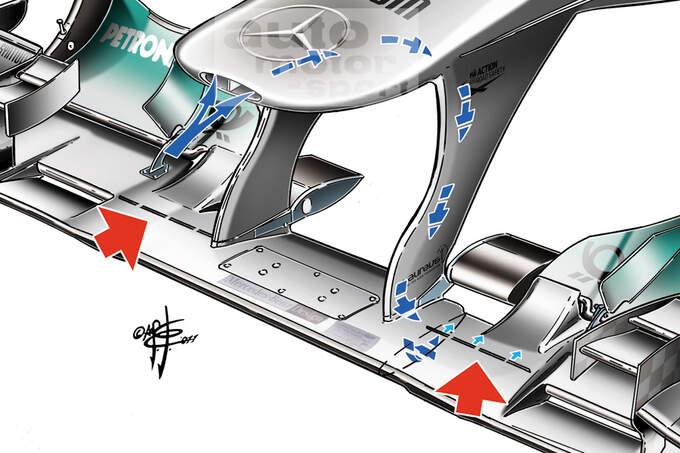This is the time of the year when we are already seeing some interesting F1 development stuff.
First I'll stop at Maranello, the home of Ferrari.
- At Korea the Italian team has been spotted to test a new front wing, link here.
- It's visible that the wing per se resembles an RBR style, and it was tested only on Alonso's car. While it hasn't been a large performance boost, it was actually expected to be a driver for data gathering.
- Stefano Domenicali himself said that the information collected from the actual race correlates with the preliminary wind tunnel data, so he's quite happy with that.
- In the race it was visible that Ferrari had much better pace with the Soft tires provided by Pirelli, something that wasn't expected, or at least not to this extent.
My next stop is the Mercedes team.
In the last races an interesting solution seems to be developed by them, namely, a passive "F-Duct" like system, located at the nose of the car. In details:
This front hole in the nose is believed to be used for cooling purposes, like electronics and the cockpit itself, but it appears that Mercedes GP team is experimenting with actually flowing air through this holes.
There's a splitter inside that hole, which is supposed to effectively flow air down the front wing.
It has been also revealed that this hole has been spotted both opened and closed, so clearly there's development going on.
It remains to be seen whether actually some of these will be deployed, and whether such solution will be considered legal. On the other hand, it's also believed that some teams are already exploiting that area.
Update: after looking a bit more into the whole concept, I'm rather skeptical that a meaningful amount of air could be channeled through those small inlets, in terms of enough air to divert to the back (or the floor) of the car.
Also, the air that has to travel through those curved / shaped object will have to face a lot of pressure, and thus will lose its initial energy and there will be a substantial loss. The air should rather be travelling from the reverse direction and possibly destroy a flow, thus stall a part of the wing?
Further reports are appearing, again at MGP side, that some interconnection between the front and the rear suspension is possible through a clever system, but for that material I will have to contact the respective owner and get a permission to link it over here.
No big news so far from Mclaren team, it's probably worth saying, however, that the chief architect of RB7, Adrian Newey, has been away from Korea GP, and it was reported by team principle Horner that he's back at the factory at Milton Keynes to work on RB8 car.
More blog posts to follow about 2012 rules itself.


